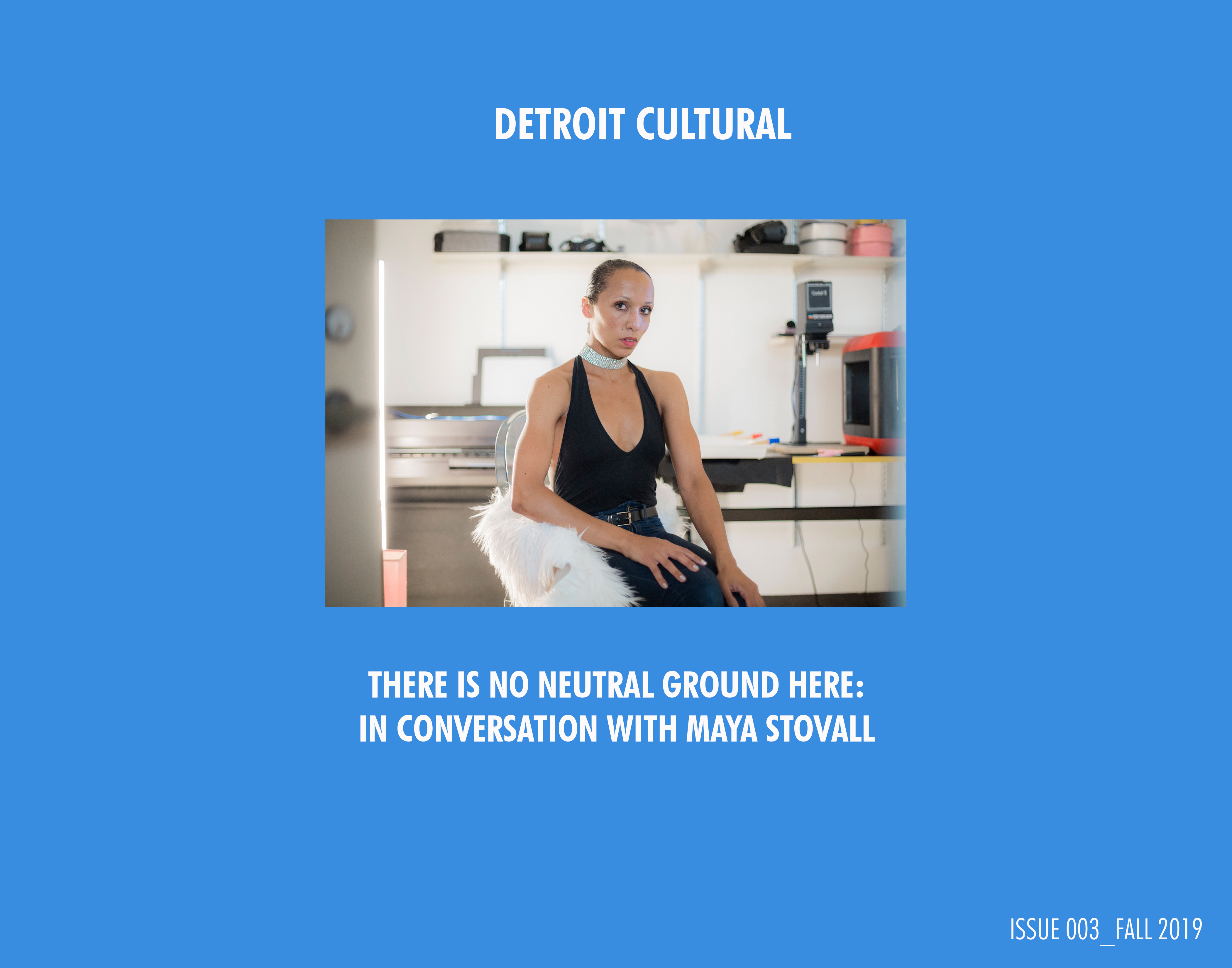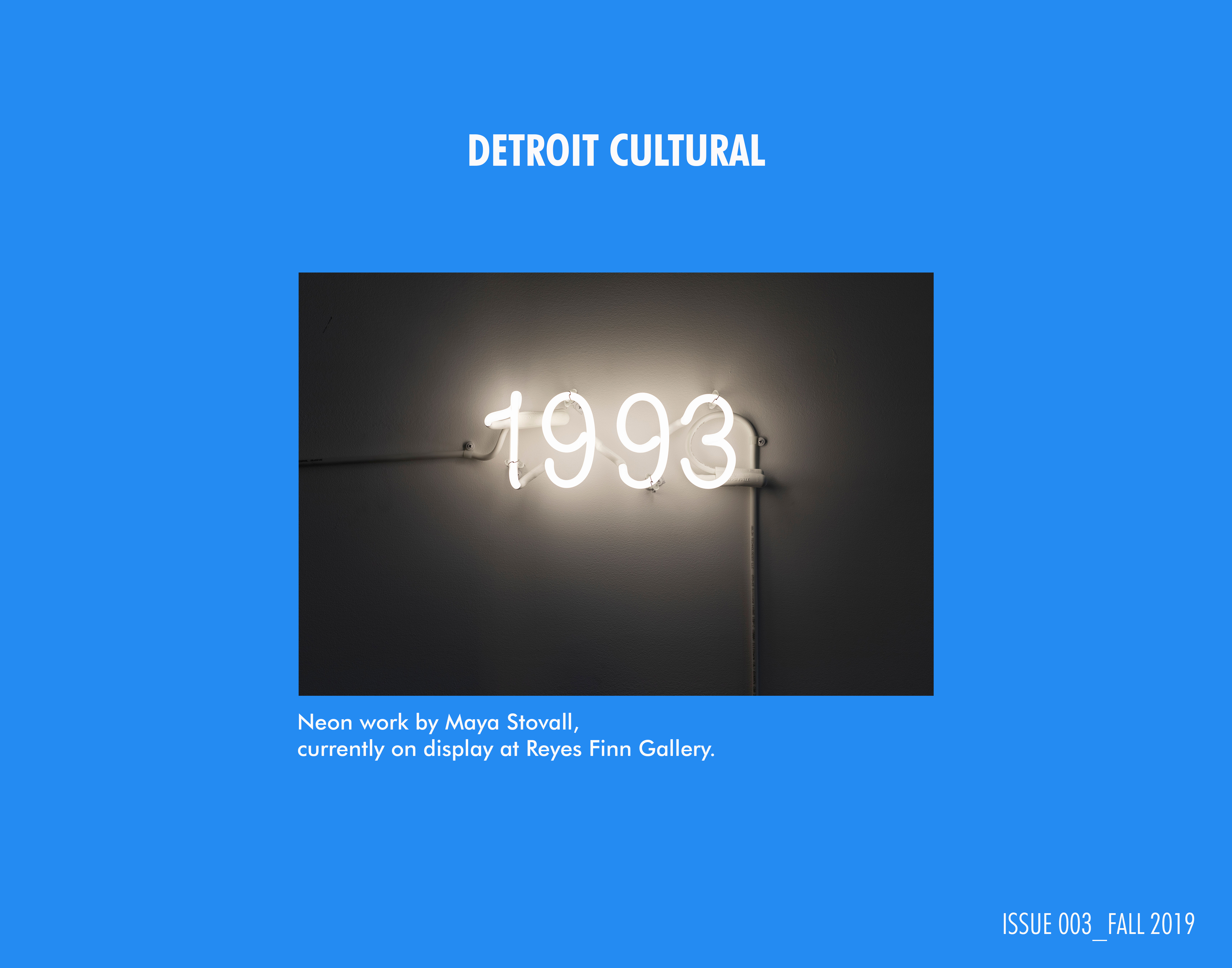
Dr. Maya Stovall (Ph.D. Anthropology) is a Whitney Biennial artist (2017), a Studio Museum in Harlem F-Series artist (2017-18), and a tenure-track assistant professor and artist at California State Polytechnic University (Cal Poly) in Pomona, Calif. Her works are included in the permanent collections at The Cranbrook Art Museum and The Whitney Museum of American Art. Her book, Liquor Store Theatre, a screenplay-style contemplation of the McDougall Hunt neighborhood on Detroit’s east side, is forthcoming August 2020 (Duke Press). Her second book with Duke, Writing Through Walls, co-authored with her brother Josef Cadwell, discusses conceptual practices and contemporary lives, from the inside and outside of United States carceral systems. Her upcoming Detroit appearances include a digital, group exhibition at the Museum of Contemporary Art Detroit (MOCAD, fall 2019) and a collaborative, concurrent, dual-solo exhibition alongside artist Todd Stovall at Detroit Artists Market (DAM, fall 2020). The artist lives and works in Detroit, where she grew up, and Los Angeles County.
As both a conceptual artist and an anthropologist, what overlaps between these two disciplines do you find most insightful to your practice?
I think about the gaps and chasms as more insightful than the overlaps.. I think of myself as I’m working as sort of riding a wave, or locating a wave that is imbued by practices connected to my work as a conceptualist and as an anthropologist. But when I see that there are spaces for questions and creation that I find pressing (?). So as opposed to layering existing frameworks I think about pursuing whatever it is that I want to pursue, that tends to be outside of existing frameworks.
Do you see them as connected or separate practices?
I don’t have a disciplinary separation in mind when I’m thinking through work, making work, and framing work. Actually I think that disciplinary separation is produced, and blocks and forecloses generative thinking. Fundamentally I’m an artist who’s obsessed with power and asking questions that revolve around structures and mechanics of power. Although I’m working through a variety of methods and theories and thinking and writing and practices that draw from genealogies of conceptual art and anthropology, I don’t think in this sort of pedantic, disciplinary way as I’m framing projects.
It is true that there are certain overlaps between the way in which Americanist anthropology emerged over the past hundred and seventy years or so, you know sort of this late nineteenth century disciplinary emergence where anthropology’s very history was connected to presenting and reducing and defining and further stratifying or organizing people in particular ways that was related to the notion of an exhibition, but in quite a different context in many ways than the notion of a museum exhibition. But the politics and agenda and mechanisms of power between art world and anthropological contexts over that Enlightenment infused timeframe are certainly integrated and are both really fraught with problematics and landmines when we review the historical record in both disciplines.

Is 19th century American anthropology where you see exhibitions that display the cultural evolutionary theory? The classification and hierarchical ranking of races and cultures?
Well that and much more. So the pseudo-scientific biologicalization, the machining and concretization of mythical racial categories was emergent for strategic political and economic reasons to support the rationale behind human trafficking and genocide of African-American victims and survivors in the United States. So anthropology was emergent along frameworks that are even more provocative and to our eyes blatantly white supremacist. And that critique has been ongoing, and decolonial and corrective anthropological genealogies have existed for decades since at least the early to mid twentieth century.
There’s a lot of material there unbeknownst to our contemporary framework has shaped much of the thinking that we’re working to destabilize yet today.
Could this critique of cultural hierarchies be placed on traditional collections based museums like the Detroit Art Institute, that they organize and present art history in such a way as to suggest an ideology of progress or hierarchy?
Absolutely. I mean there is no question that art historical canon, I mean every sort of discipline that we consider is shaped by the same trajectory, momentum and public discourse. There’s just no question about it. There’s no separation. This is all intertwined and interwoven.
Do you think it’s ever possible for art to exist outside of a political context?
Well the notion that anything under the sun could be outside of a political context is a political statement. So I think that, not to obliterate the question, but to say that everything under the sun is political, that includes art, so of course there are many different sorts of pathways to explore within that reality, and we can explore some of them. The fact that our thinking is shaped by notions of knowledge that our produced, and notions of truth and value, commodification and fetishization that are produced, is inherently produced. The statement that art can exist outside of a political framework is a political statement. There is no neutral ground here which is interesting.
But I think what is equally interesting, and I think there is this tightrope or piece of elastic that we are pulling and finding the limits of, is that all art is well is implicated in political economy and capital relations, and so regardless of what an artist or artwork of art is doing, we are inherently working in an institutional context that at its core is demanding revolution. The idea that there is some sort of particular type of art that is somehow more privileged than other types because it ostensibly or superficially presses contemporary questions, to think that that type of art is somehow outside of problematic and fraught institutional framework is equally fatigued as the idea that art can exist outside of a political framework. The critique goes both ways. The fatigue of that question, or the fatigue associated with those ideas that are so well worn and need to be torn apart, is really compelling to think through.
One response to that question that I’ve been personally thinking through is the idea that by claiming everything is political– that nothing can be removed from a political context– drains the very word “political” of its meaning. What do you make of this?
The fact is that that statement puts the question in another place, it dislocates the questions, and to state that the word ‘political’ is depolicitized by stating that everything is political, is itself a political statement. We’re back in the realm of a sort of philosophical critique of pure reason. To state that you take away the meaning of the word “political” when you state that everything is political is a political statement, and that’s also political. And the reason for that is because well what does political mean? So we’re talking about tension, conflict, struggle, class struggle, so to state that everything is connected to a political framework is actually an empirical statement that can be supported by data in the world and can’t be mystified, so by attempting to mystify the word you’re putting the discussion in an entirely different place, and I won’t let that happen. The person who said this I’m sure has reasons that are meaningful to them and that’s great, people should think and make whatever they want. But to abstract a word and make an argument based upon that is a political act.
In our contemporary context in which anything can be framed as “art”, what do you believe is the importance of distinguishing an action, object, moment, etc. as “art”?
So I don’t think that anything can be art. I think sure anything in terms of any commodity, any object, any piece of matter in the world, or kernel of an idea can be art, but from the sort of idea that we can just point at anything in the world and say, “that’s art,” that I think gets us into a place where we’re in a loosey-goosey framework. My thought is that intent, in whatever sort of media one is working within, intent and attention and frame are necessary for art in the way that we’re discussing in this particular context. So I don’t think that everything is art in that way, although of course everything has the possibility to be machined into works, sure, however I think intent and frame are critical. And what separates work that is invested and compelling and has teeth and legs and tentacles from work that is less so, I think ultimately you’re boiling down to the mind of the artist and the mind of the viewer and publics and how those sorts of relationships are deliberately calibrated by the artist and collaborators and publics and whatever the particular ecosystem at hand requires.
Does artmaking offer anything unique to civic engagement?
Yeah hopefully activate people’s brains, hopefully encourage questions, aggregate and investigate questions that are difficult to pursue in more restrictive contexts.
What do you see as the political and social responsibilities of art practice?
So I think the political and social responsibilities of being human also apply to artists. I don’t think there are a particular privileged set of conditions that apply to artists, we’re humans on this earth doing work, and the same rule applies if you’re shoveling ditches, scrubbing toilets, doing research, the conditions that are applicable to moving in the world with care apply. Not to make the question seem so simple, but to me that’s where it’s at.